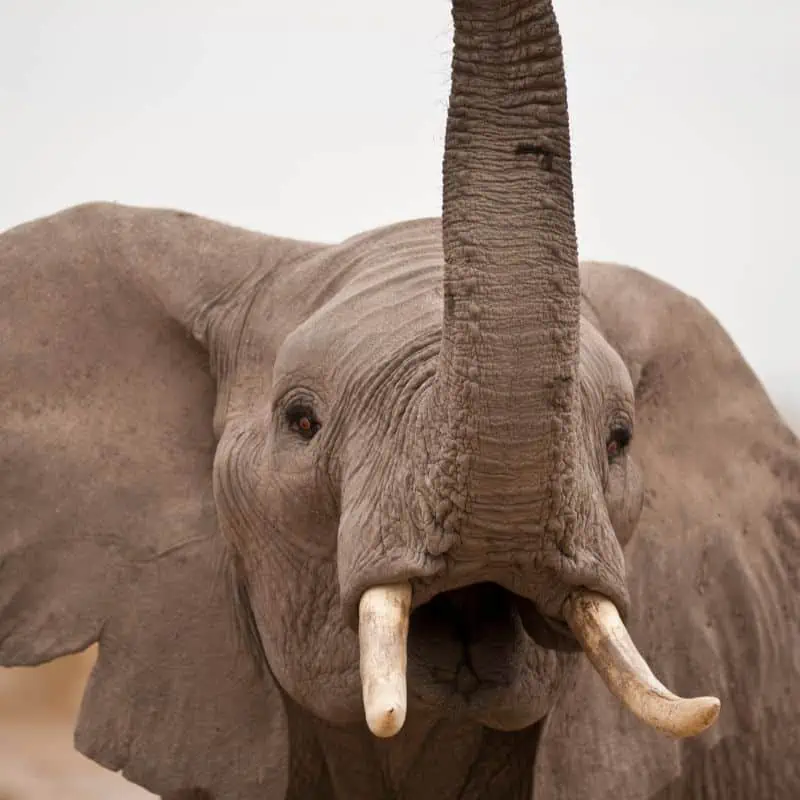Animals produce different and unique sounds to communicate with each other. Have you ever heard an elephant scream, moving its trunk up and opening its mouth underneath the trunk? What is that sound an elephant makes?
Elephants can create a range of sounds. They express their emotions, alert the herd of danger, or call for mating by making very low-frequency rumbles to high-frequency noises. The trunk and throat (or larynx) help them create different sounds with variable frequencies. Elephants also sense a sound made by their peers from a long distance.
How do elephants communicate? What sound does an elephant make? Are there any sounds other than trumpeting and rumbling? Let’s take a look at this and more in this article.

What Does an Elephant Sound Like?
An elephant produces a variable sound depending on the mood, emotion, and situation. The sounds may differ among bulls (male elephants), cows (female elephants), and calves (baby elephants).
In general, elephants produce sounds like:
- Trumpeting
- Rumbling
- Roaring
- Barking
- Snorting
- Grunting
These sounds are so alike yet different among a group of elephants.
Elephants, just like other animals, can differentiate among their family members, groups, and genders based on the sound they produce.
In contrast, it may not be understandable for humans.
Common Elephant Sounds
People can identify the two most common elephant sounds: trumpeting and rumbling.
You might be more familiar with the trumpeting sound, but elephants use a rumbling noise more often for everyday communication.
Trumpeting Sound of Elephants
Elephants produce a trumpeting sound by breathing in air through the trunk.
They fold, unfold, twist, and untwist the trunk to change the frequency of the sound. Moreover, the sound is resonated and amplified in the trunk into variable frequencies.
Rumbling Sound of Elephants
The rumbling sound is generated using the larynx. The elephants push out the air from their lungs.
The air then passes through the larynx and is expelled from the mouth to make noises with different frequencies.
Elephants can make these noises loud or quiet by opening a big or small mouth. They can also modify their rumbling sound using their trunks.
What Does Trumpeting Mean?
Trumpeting is a high-pitched sound produced from the trunk of an elephant. So the trunk not only helps in breathing but also helps the elephant produce loud sounds.
The elephant trunk acts as a loudspeaker, vibrating and resonating a loud, high-frequency sound.
Even though elephants use the trumpeting sound for short-range communication, their loud trumpet sounds can travel up to 6 miles, helping communicate with the other elephants over a long distance.
Trumpeting is like a warning signal or a threat to predators from elephants to show their dominance.
Elephants also produce a trumpeting sound when joyful, excited or angry. When angry, elephants make a loud trumpet blast to show their aggression.
Given the frequency, intensity, and loudness, trumpeting sounds are also audible to humans.

What Does it Mean When an Elephant Rumbles?
These sounds have a low frequency, travel longer distances, and are inaudible to the human ear.
Elephants rumble differently based on what they want to convey to their fellow pachyderms. The fellow elephants far away in the landscape can feel these rumbles under their feet and respond accordingly.
These are the sounds that elephants usually use for everyday communication. Elephants emit a soft, low-frequency greeting rumble to greet each other, along with flapping their ears.
Furthermore, elephants produce mating rumbles to attract the opposite gender. The male elephant makes a musth rumble when in search of a mate.
In response, a female elephant emits an estrous rumble to alert the bulls.
A baby elephant produces begging rumbles when asking for suckling. Baroo-rumbles have whining tones usually produced by a calf, as a response to which an adult elephant rumbles to reassure the baby elephant.
Similarly, cows and calves make cooing rumbles when cuddling.
Other Sounds Produced by Elephants
Elephants also make sounds other than trumpeting and rumbling. For instance, they might produce a powerful rumble coupled with a trumpet blast called roaring.
Female elephants make chirping or squeaking noises to communicate with other females or calves or to express happiness.
When sad or anxious, elephants produce a high-pitched sound.
Moreover, elephants also make grunting or snorting noises, almost like a trumpet.
A human might not be able to differentiate between these sounds. But elephants can easily tell them apart.
Final Thoughts on What Sound Does an Elephant Make?
So now you know how elephants communicate with each other. These mammals talk for real with their peers.
We learned that elephants usually make a rumbling sound to meet and greet every day.
Moreover, they can change their rumbling frequency to express different emotions.

FAQs
Can Humans Hear an Elephant Sound?
Humans can hear high-frequency sounds produced by elephants, like trumpeting, roaring, or grunting. The low-frequency sound, like rumbling, is not audible to a human ear. These sounds are infrasonic with a frequency of less than 20 Hertz. Hence, the human ear can not catch low-frequency sounds.
How Does an Elephant Detect a Sound?
The massive ears of elephants help detect a low-frequency sound that a human ear can not perceive. Moreover, elephants have very sensitive nerve endings, which allow them to feel the underground vibrations from elephant rumbles and stomps. Therefore, elephants are also very good at sensing a thunderstorm or approaching predators.
Can Elephants Imitate Other Sounds?
Researchers believe that elephants can produce imitating sounds for social communication. They can copy their members from the herd and adapt their frequency to sound exactly like their peers. Furthermore, elephants have been seen to imitate truck noises and mimic chirp-like sounds of other species and animals.

